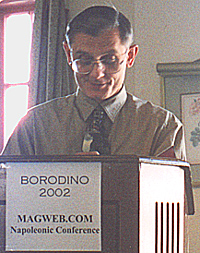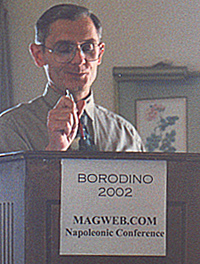 Dr. Gregor from the US Army School of Advanced Military Studies at Fort Leavenworth, flew in to be the keynote speaker for the conference. Here, he strikes a cautionary note for modern military planners about relying too much on Napoleon for studying the art of operational warfare. I should note that all comments are Dr. Gregor's opinions and do not represent the official positions of the US Army, US Government, or any other organization. He had to say that for legal requirements, I expect, so I'm repeating him lest someone get too carried away by his words. --RL
Dr. Gregor from the US Army School of Advanced Military Studies at Fort Leavenworth, flew in to be the keynote speaker for the conference. Here, he strikes a cautionary note for modern military planners about relying too much on Napoleon for studying the art of operational warfare. I should note that all comments are Dr. Gregor's opinions and do not represent the official positions of the US Army, US Government, or any other organization. He had to say that for legal requirements, I expect, so I'm repeating him lest someone get too carried away by his words. --RL
Why study Napoleon? First you have to understand that it's an Army affectation. The Navy pays slight attention to the period, and certainly the Air Force ignores the era. And the Army breaks down military history into three eras: pre-WWI, WWI to 1965, and 1965 to the present.
At the beginning of the 19th century, no army had a professional officer corps. The great generals learned via field experience, with perhaps some additional teachings to younger members of the nobility. But by and large, compared to today's educational institutions, the commanders of old were amateurs who learned on the job. The British Army's purchasing of ranks is an excellent example of the amateur status conferred upon the army.
And yet, in a profession as important as the military, a change began to take place about the way we thought about war and about the way we studied it and taught it. The early schools, including the US' West Point and the French Ecole that Napoleon attended, were primarily engineering and artillery schools.
It wasn't until August 6, 1808 that a professional military institution was established--and that was in Prussia, where advancement in peacetime would be via education and proficiency of knowledge. Wartime promotions would still include experience and battlefield prowess. But the idea had been started about the development of a professional core group of officers as well as the educational facilities and institutions to support them.
In the US, the US Military Academy at West Point becomes the only profesional school to study the art of war beyond artillery or engineering--and that only starts in 1817. When the curriculum was created, the studies centered on the last great set of wars: the Napoleonic Wars. This coincided with an era in which people expressed interest in "great" individuals, like Napoleon.
Interestingly enough, most of the "textbooks" were created by amateur study. For example, Hardee's Tactics are probably the best known prior to the American Civil War, because Hardee did the translation. Jomini's analysis of tactics, written in the 1830s, wasn't fully translated until 1862 by a pair of West Point Engineering Officers. In between 1817 and 1862, you relied on the amateur studies: Hardee et al.
By the latter half of the 19th century, although Napoleonic information was available, the art of large unit maneuvers was interesting, but non-essential to US operations. Most army activity was out West, where smaller units fighting against Indian tribes made up most of the battles, not corp on corp armies maneuvering across the land. Still in 1881, the US Army established a special school of warfare at Fort Leavensworth while Jomini started to be used in 1889.
In WWI, there were more troops to deploy, but given the static nature of trench warfare, little in the operational art of maneuver was needed.
 After WWI
After WWI
In December 1921, a change occured within the army where the very art of war was redefined in manual 10-5. The Napoleonic campaigns were an easy vehicle for the discussion of various principles of war: surprise, maneuver, objectives, etc.
Yet at the advanced schools, such as those in Fort Leavensworth, history was not a major component of the studies until 1935. In that year, Willoughby wrote a book called Maneuver and War, which attempted to link the past and present. In his foreward, he offers the best answer to the question: Why Study History?
"In absense of practical experience, operative skill is only acquired through the careful study of great campaigns."
In essense, he argues that history can substitute for experience, and that at the time of his writing in 1935, the operational art of maneuvering large units, even within the limited parameters of trench warfare, was being lost as first-hand commanders died out.
Willoughby's writing was not necessarily influential at the time, indeed, perhaps obscure is too kind a word, but his ideas would be resurrected, especially in 1973 and beyond.
After 1965
From 1965 to 1973, the Vietnam War provided a battlefield to test various US operational arts, and the results are history. Col. Harry Summers, the great apologist for the US in Vietnam, called for the return of Clauswitz and other Napoleonic principles for operational level war.
From 1973 to 1986, the so-called "Renaissance of the US Army" occurred as lessons from this last war started to be examined. The idea that the US won all the battles but lost the war took hold, and so bringing the idea of linking all these battles together to win a war caught hold. The Yom Kippur War also played out during this time, bringing more ammunition to the study of history and the operational art of war as produced by various great captains, led by the Combat Studies Group.
In 1973, the US Army created TRADOC to restart the process of developing doctrine for the US Army. The first manual was poorly received as being "too tactical" and not enough operational, and providing no guidance for Corp and Army level commanders. And yet, it began the discussion of the merits of "Maneuver vs. Firepower Attrition."
In 1982, FM 100-5 arrived, reintroducing the operational art of war into official US Army doctrine. It was not perfect by a long shot in covering from the tactical level to the strategic level, and it only vaguely alluded to how tactics could be linked to overall strategy.
In 1986, the School of Advanced Military Study (SAMS) was formed to do exactly that--examine and analyze the link between the two ends of the spectrum. And here they started to draw on Jomini and Clauswitz and other Napoleonic-era ideas. The result was a revised FM 100-5 in 1986.
Thus, for the past 20 years, US Army military officers in advanced schools were required to reacquire knowledge of the operational art.
Why Should You Still Study Napoleon?
Here's where Gregor starts to drift away from the study of pure Napoleonic history. In October 1986, the Goldwater-Nichols Act passed to start examining the operational art of war not just from a pure US Army command, but as a joint command. This new "Joint Doctrine" effectively no longer makes the Army the focus of operations, although as you might expect, the Army's 1993 and 2001 manuals show little movement towards the concept.
At SAMS, Napoleon is still taught and his campaigns help students process operational art. In various courses, students look into Clauswitz and Jomini, although in Gregor's opinion, students must learn to differentiate between historical studies and contemporary ones. He notes that he's tired of reading yet another student monograph about "decisive maneuvers" of 2010 as if Napoleon was still striding the battlefields of Europe. Of course, when the campaigns of Ulm, Austerlitz, Jena-Auerstadt, and Borodino are included, what else can you expect.
SAMS also uses computer simulations to highlight the difference between the two. There's one built one around the 1813 campaign, which takes four days as part of the larger overview of three eras of warfare: classical (up to 19th century), Industrial (Napoleonic to WWI), and Mechanical (WWI-present).
On the computer side, SAMS also uses the Operational Art of War by Talonsoft, though heavily edited for 19th century warfare. It looks like how Clauswitz and Jomini conceived Napoleonic warfare, therefore, it must be, but that's not the operational realities of modern warfare. The main problem is that students must move every unit--simple per se, but not an accurate reflection of what you, as a commander practicing the art of operational warfare, are likely to encounter on the modern battlefield.
Gregor prefers Wargamer (circa 1985). The original was buggy, but the subsequent patches have made it stable. And the biggest advantage for modern day students--you issue orders, but the computer moves the units. The realism factor is higher with Wargamer than Operational Art of War, because a game can be operational if subordinates take care of movement, but cannot be operational is you as overall commander have to pick up and move every unit in your command.
In the 1813 simulation, Gregor isolates the commanders from the computers in the room so they cannot watch the units move across the screen. The commander only received status reports.
Defeat Army vs. Political Ends
In the 19th Century, the goal of operational war was to defeat the enemy army. Modern day operations are a great deal more complex. Commanders today see a completely different battlefield than those in Napoleon's time. Political concerns intrude and there are a whole set of pressures -- logistics, airpower, etc -- that were not there in the Napoleonic era.
While it is pleasant nostalgia to go back to a simpler time, the reality is that modern battlefields are not so simple in goals or operations. The new focus, and correct focus Gregor adds, is on joint operations. And the more joint operations on hand, the less the focus on the Army and the more on the focus of an operational joint commander. That may or may not sit well with the Army structure, but it is the future, and it is up to SAMS and other command schools to examine and experiment with joint forces, and then to bring out a joint doctrine.
More Borodino 2002 Napoleonic Conference
- Welcome, Introduction, and the Hotel Chamberlain
Borodino Ballroom
MagWeb.com Napoleonic Speakers Conference
Friday Lecture: Bob Coggins: Napoleonic Unit Frontages and True Linear Scale
Friday Lecture: Frank Chadwick: The Russian Army at Borodino
Friday Lecture: Jean Lochet: Preparation of French Cavalry for Campaign of 1812
Friday Tour: Fort Monroe Casemate Museum
Friday Keynote Lecture: Dr. William J. Gregor: Long Shadow of Napoleon on American Military Planning
Friday Lecture: Jean Lochet: The Attempt to Rebuild the French Cavalry for 1813
Saturday Lecture: Kevin Zucker: The French Army of 1812
Saturday Lecture: Dr. James H. Birdseye: Glory or Shame? The Role of Morale on the Napleonic Battlefield
Saturday Lecture: Dr. George Nafziger: Prelude to 1812: The 1809 Campaign in Poland
Special Guest: Lt. Col. Andrey Pavlov: Deputy Military Attache from the Russian Embassy
Saturday Lecture: Glenn Drover: Napoleonic Game Design and Production
Saturday Lecture: Jean Lochet: The Peace Conference of Prague: Negotiations with Napoleon During the 1813 Armistice
Video Presentation: Dr. Ben Weider: Borodino Re-enactment 1997
Video Presentation: Austerlitz and Sharpe
Re-enactor Presentations: Russians and French
Borodino: The Wargame
Side Wargames: Survivor, et al.
Awards Banquet
Back to List of Conventions
Back to Travel Master List
Back to MagWeb Master List of Magazines
© Copyright 2002 by Coalition Web, Inc.
This article appears in MagWeb (Magazine Web) on the Internet World Wide Web.
Other military history articles and gaming articles are available at http://www.magweb.com